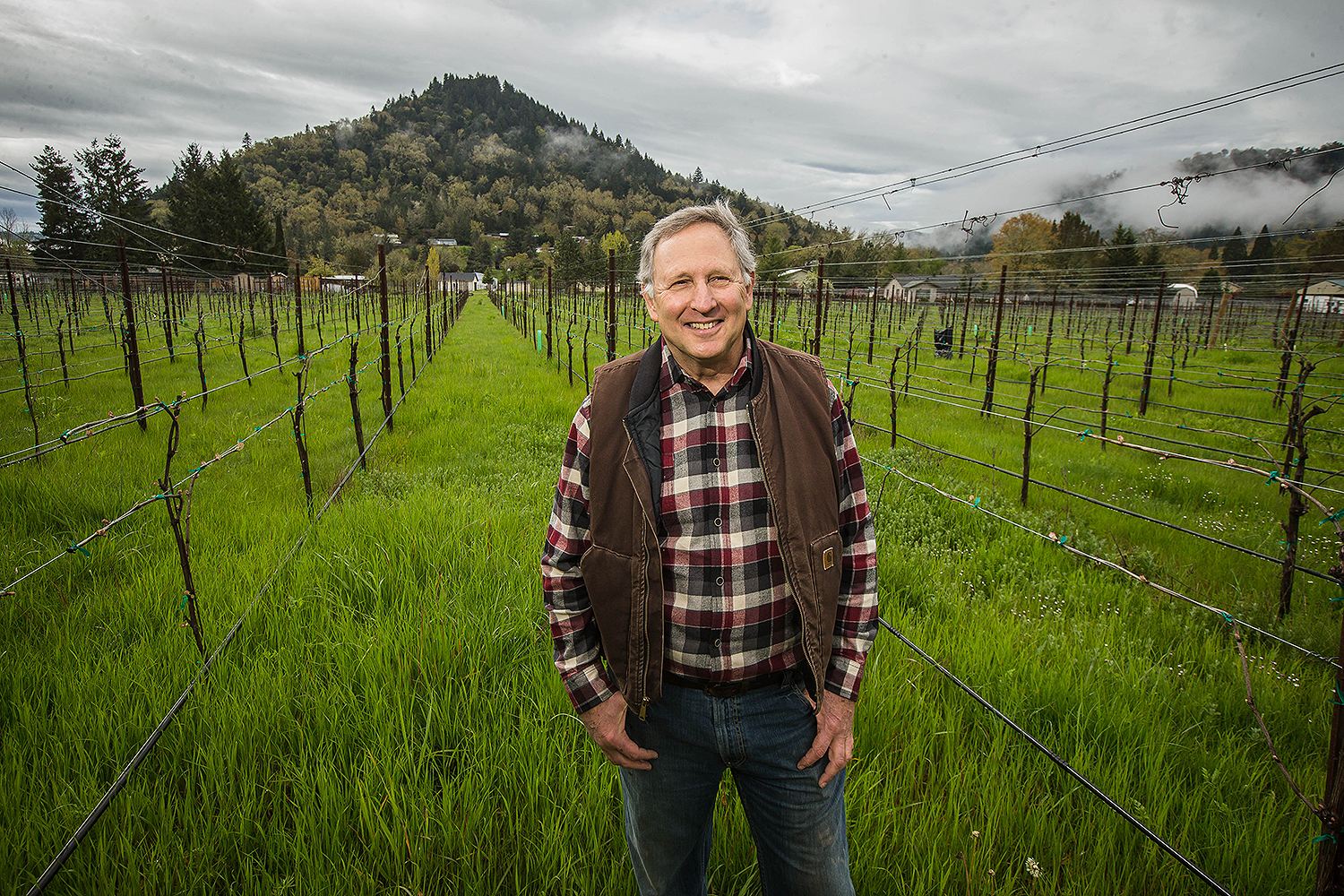The Wine Doctor

It took a few years, a lot of elbow grease and the lion’s share of his free time over the last several years, but with the opening of Foon Winery cardiologist Howard Feldman can now add winemaker to his list of accomplishments.
Story by Dick Baltus, Photos by Chris Pietsch
The first time Dr. Howard Feldman laid eyes on the structure that now serves as the beautiful tasting room for his new winery, it was not a pretty sight. In fact, it was downright scary.
While many locals remember the old building (circa 1850) on Busenbark Lane that previously housed Champagne Creek Winery, and before that Callahan Ridge, those tenants were before Feldman’s time in the Umpqua Valley. So his first visit, not long after he arrived in these parts a decade ago, was unencumbered by any sense of nostalgia that may have softened his impression.
“It was like walking into a barn,” he remembers. “It looked like a haunted house. There were holes in the roof you could drop a cow through.”
As Feldman continues his visual tour through the rundown building, his adjectives and metaphors get even more descriptive. But you get the idea — this was not the ideal foundation upon which to build a new winery from scratch.
“I thought to myself, ‘Now here is an excellent opportunity to lose my shirt; I cannot pass this up,’” Feldman cracks.
Anxious to share his discovery, he snapped a few photos, promptly sent them to his wife, Marjorie, a local artist, then eagerly awaited her response.
“I think she may have threatened my life,” Feldman recalls, with a laugh. “I said, ‘No, no, this has a great feeling to it — the feeling of imminent bankruptcy.’”
He designed and built the entry to Foon Winery. John and Judy Waller Photography.
Years later, on an autumn Sunday morning, sitting at the large community table he built for his tasting room and with the formal opening of Foon Winery about an hour away, it’s easy for Feldman to laugh at the earliest memories of this venture.
It has, after all, turned out to be pretty impressive.. The old barn that served as the Feldmans’ home while theirs was being built on the site is now a warm and inviting tasting room and includes a kitchen and gallery featuring the works of Marjorie (whose art also adorns the Foon labels) and others. If any barnyard beast ever occupied this space, delivered through the roof or by other means, there is no evidence of it.
Outside, a new covered entryway welcomes visitors inside, where they can taste a variety of Foon wines, including albarino, malbec, tempranillo and viognier.
The whole thing takes on even more significance when it comes to light that Feldman had his hands in almost every aspect of the winery’s development. He did all the planning for the vineyard, all the spraying, mowing and trimming. He helps pick and crush grapes.
Feldman is responsible for much of the woodwork in the tasting room. Besides the table, fashioned from beautiful native curly redwood, he made all the trim, the doors and the covered entryway. He designed and fabricated the ornate front gate and graded the road that leads from it to the tasting room.
What else? Oh, the wine. Yeah, he makes that too.
In what appears to be his spare time, Feldman is a renowned interventional cardiologist who this year celebrated a decade at the helm of Mercy’s Shaw Heart and Vascular Center. Since 2007, he has overseen the dramatic expansion of Mercy’s cardiology staff and capabilities.
Under Feldman’s leadership, the center’s interventional cardiology program has dramatically changed the lives of hundreds of area patients whose risk of heart attack or limb amputation has been dramatically reduced, or eliminated altogether, by non-surgical procedures to restore blood flow through blocked vessels. A comprehensive electrophysiology program also has been established to diagnose and treat abnormal heart rhythms.
Shaw Heart’s status on the national level has grown as well. It was the first program west of Texas to earn national Accreditation for Cardiovascular Excellence certification from the American College of Cardiology. An annual conference hosted by Feldman and Shaw Heart Center attracts to its faculty and educational sessions some of the world’s most respected cardiology authorities.
It’s not the most predictable career path. It began in New York City, Boston and Los Angeles — where Feldman was educated and trained — and continues in the smaller community of Roseburg. It’s a long story how he got here, but the abridged version is he was good at starting heart programs; Mercy needed someone to do just that; and Feldman was ready to settle down with his family in a smaller community.
“I had multiple opportunities to practice in large cities,” he says. “But the anonymity of practicing in a large metropolitan setting doesn’t come close to matching the reward of running into your patients in Sherm’s Thunderbird. I enjoy that sense of community.”
Also, there’s not a lot of great wine coming out of downtown Los Angeles. Feldman was bitten by the winemaking bug while living in Sonoma County in the early ’80s, and the Umpqua Valley’s burgeoning wine scene made the opportunity Mercy was presenting all the more appealing.
He started making and bottling wine in his new locale while still rehabbing buildings on the six-plus-acre property. Early on he learned the existing vineyard was planted with varietals that generally could not do well on the site and was without a trellis system. That required tearing out all the existing vines and replanting, but by 2011 Feldman and Foon had produced their first tempranillo.
Dr. Howard and Marjorie Feldman in front of the ornate entry gate he designed and fabricated.
Those early bottles were, he says, searching for just the right word, then dragging it out far beyond the typical time required to expel two syllables, “Ghastly.”
“It would be hard to imagine anything so dreadful,” he expounds. “It wasn’t fit for vinegar.”
But, as a physician, Feldman is a lifelong learner. So he kept researching, consulting both published sources and local experts, like climate expert Greg Jones and winemaker Steve Reustle.
“Many people in the local wine community were very helpful,” Feldman says.
Before long, Feldman was producing bottles that didn’t require warning labels. “I’ll never forget having a dinner guest over in 2015 and opening a bottle of 2013 tempranillo. She actually smiled when she took a drink and described it as ‘lovely.’ That was the first wine that made me think maybe we could do this.”
So do it he does. As with his professional endeavor, there is no end to the winemaking learning process. Just as no two heart patients ever recover in identical manners, grapes and winemaking present multiple, and sometimes unique challenges, Feldman says.
“Every patient is different. You can take identical steps in their treatment, but some flourish more readily in your care than others. In the same way, all tempranillos are fermented the same way, but some ferment like crazy while others are a little slow. I have this recurring nightmare that I’m going to wind up with a ‘stuck’ fermentation and lose a lot of wine.”
Up to now, nothing has stuck. It took several years and a lot of hard work, but Foon Winery is open for business. And, 10 years after moving to town, Feldman is leading a state-of-the-art heart center that is widely recognized for the quality of care it provides local patients.
Those are both occasions to celebrate, so grab a bottle and raise a glass. Pretty much everything from Foon will put a smile on your face except, apparently, a certain 2011 tempranillo.







